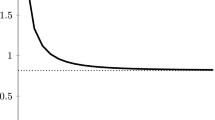Abstract
This article investigates a set of partial differential equations, the DT-instanton equations, whose solutions can be regarded as a generalization of the notion of Hermitian–Yang–Mills connections. These equations owe their name to the hope that they may be useful in extending the DT-invariant to the case of symplectic 6-manifolds. In this article, we give the first examples of nonabelian and irreducible DT-instantons on non-Kähler manifolds. These are constructed for all homogeneous almost Hermitian structures on the manifold of full flags in \(\mathbb {C}^3\). Together with the existence result we derive a very explicit classification of homogeneous DT-instantons for such structures. Using this classification we are able to observe phenomena where, by varying the underlying almost Hermitian structure, an irreducible DT-instanton becomes reducible and then disappears. This is a non-Kähler analogue of passing a stability wall, which in string theory can be interpreted as supersymmetry breaking by internal gauge fields as in Anderson et al. (J High Energy Phys 09:026, 2009).


Similar content being viewed by others
Notes
Any nearly Kähler manifold is Einstein with positive scalar curvature. Hence, if it is complete, must actually be compact.
The two irreducible HYM connections existing for \(s<s_0\) are actually gauge equivalent, see Remark 6.2. However, the gauge transformation exchanging them fixed the reducible HYM connection existing at \(s=s_0\).
References
Anderson, L.B., Gray, J., Lukas, A., Ovrut, B.: Stability walls in heterotic theories. J. High Energy Phys. 09, 026 (2009)
Baulieu, L., Kanno, H., Singer, I.M.: Special quantum field theories in eight and other dimensions. Commun. Math. Phys. 194(1), 149–175 (1998)
Baulieu, L., Losev, A., Nekrasov, N.: Chern–Simons and twisted supersymmetry in various dimensions. Nucl. Phys. B 522(1–2), 82–104 (1998)
Bryant, R.L.: On the geometry of almost complex 6-manifolds. Asian J. Math. 10(3), 561–605 (2006)
Bryant, R.L.: Some remarks on \({\rm G}_2\)–structures. In: Proceedings of Gökova Geometry-Topology Conference 2005, Gökova Geometry/Topology Conference (GGT), Gökova, pp. 75–109 (2006)
Charbonneau, B., Harland, D.: Deformations of nearly Kähler instantons. Commun. Math. Phys. 348(3), 959–990 (2016)
Donaldson, S.K.: Anti self-dual Yang–Mills connections over complex algebraic surfaces and stable vector bundles. Proc. Lond. Math. Soc. 3(1), 1–26 (1985)
Donaldson, S.K., Segal, E.P.: Gauge theory in higher dimensions, II, Surveys in differential geometry. Volume XVI. Geometry of special holonomy and related topics. Surv. Differ. Geom. 16, 1–41 (2011)
Foscolo, L.: Deformation theory of nearly Kähler manifolds. J. Lond. Math. Soc. 95(2), 586–612 (2017)
Iqbal, A., Vafa, C., Nekrasov, N., Okounkov, A.: Quantum foam and topological strings. J. High Energy Phys. 04, 011 (2008)
Lubke, M., Teleman, A.: The Kobayashi–Hitchin Correspondence. World Scientific, Singapore (1995)
Oliveira, G.: Monopoles in Higher Dimensions, Ph.D. Thesis (2014)
Oliveira, G.: Calabi–Yau monopoles for the Stenzel metric. Commun. Math. Phys. 341(2), 699–728 (2016)
Tanaka, Y.: A weak compactness theorem of the Donaldson–Thomas instantons on compact Kähler threefolds. J. Math. Anal. Appl. 408(1), 27–34 (2013)
Tanaka, Y.: A removal singularity theorem of the Donaldson–Thomas instanton on compact Kähler threefolds. J. Math. Anal. Appl. 411(1), 422–428 (2014)
Tanaka, Y.: On the moduli space of Donaldson–Thomas instantons. Extracta mathematicae 31(1), 89–107 (2016)
Thomas, R.P.: Derived categories for the working mathematician, Winter School on Mirror Symmetry, Vector Bundles and Lagrangian Submanifolds (Cambridge, MA, 1999). AMS/IP Stud. Adv. Math. 23, 349–361 (2001)
Thomas, R.P.: Gauge Theory on Calabi–Yau manifolds, Ph.D. Thesis (1997)
Uhlenbeck, K., Yau, S.-T.: On the existence of Hermitian–Yang–Mills connections in stable vector bundles. Commun. Pure Appl. Math. 39(S1), S257–S293 (1986)
Verbitsky, M.: Hodge theory on nearly Kähler manifolds. Geom. Topol. 15(4), 2111–2133 (2011)
Wang, H.C.: On invariant connections over a principal fibre bundle. Nagoya Math. J. 13, 1–19 (1958)
Acknowledgements
We would like to thank Benoit Charbonneau, Gäel Cousin and Lorenzo Foscolo for helpful conversations regarding this article. We are particularly thankful for Benoit Charbonneau’s comments and carefully reading a previous version of this article.
Gonçalo Oliveira is supported by Fundação Serrapilheira 1812-27395, by CNPq grants 428959/2018-0 and 307475/2018-2, and FAPERJ through the program Jovem Cientista do Nosso Estado E-26/202.793/2019.
Author information
Authors and Affiliations
Corresponding author
Additional information
Communicated by S. Gukov.
Publisher's Note
Springer Nature remains neutral with regard to jurisdictional claims in published maps and institutional affiliations.
Appendix A. The topology of the bundles \(P_{\beta }\)
Appendix A. The topology of the bundles \(P_{\beta }\)
Recall that the bundles \(P_{\beta }\) are constructed via \(P_{\beta }= \mathrm{SU}(3) \times _{(T^2, \lambda _{\beta })} \mathrm{SO}(3)\), where
Let \(V_{\beta }=P_{\beta } \times _{SO(3)} \mathbb {R}^3\) be the vector bundle associated with respect to the standard representation SO(3)-representation, and consider the \(\mathrm{U}(2)\) bundle
where
and the ismorphism. This has the property that the \(\mathrm{U}(2)\)-adjoint bundle of \(E_{\beta }\) splits as \(\mathfrak {u}_{E_{\beta }} \cong \underline{\mathbb {R}} \oplus V_{\beta }\) and
We shall now compute the Chern classes of the bundles \(E_{\beta }\) using Chern-Weyl theory. For this we must equip \(E_{\beta }\) with a connection which we choose to be the standard invariant connection given by
This has curvature \(F_{\beta } = d\beta \otimes \mathrm {diag}(i,0)\) and so
Furthermore, a computation using the Maurer–Cartan equations shows that
and so in \(H^4(\mathbb {F}_2, \mathbb {Z})\) we have
So, writing \(\beta = k \beta _1 + l \beta _2\) we compute that
while
In particular, when \(\beta \) is one of the roots \(r_1\), \(r_2\), \(r_3\) we respectively obtain
so these three bundles are all topologically different.
Rights and permissions
About this article
Cite this article
Ball, G., Oliveira, G. The DT-Instanton Equation on Almost Hermitian 6-Manifolds. Commun. Math. Phys. 388, 819–844 (2021). https://doi.org/10.1007/s00220-021-04206-8
Received:
Accepted:
Published:
Issue Date:
DOI: https://doi.org/10.1007/s00220-021-04206-8



